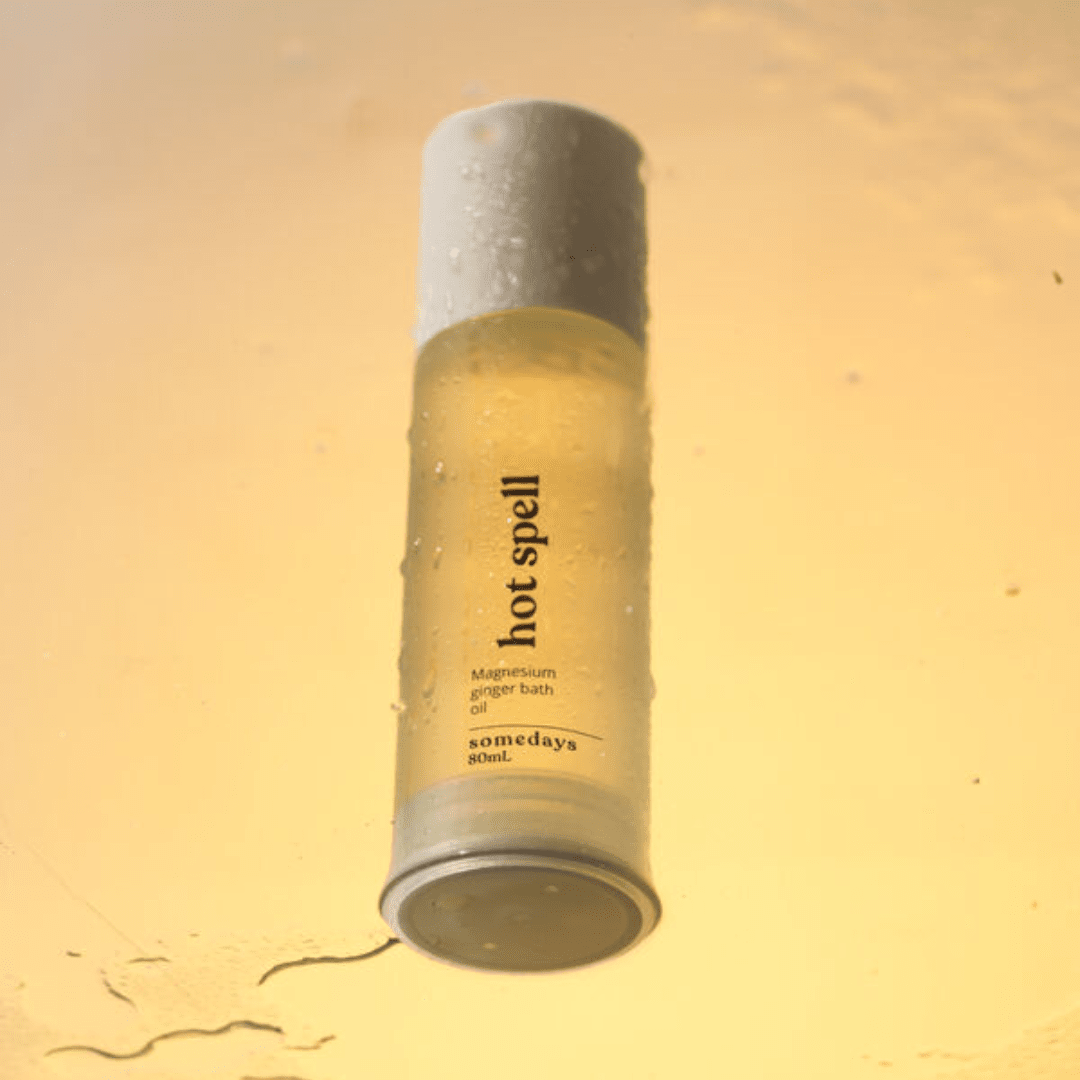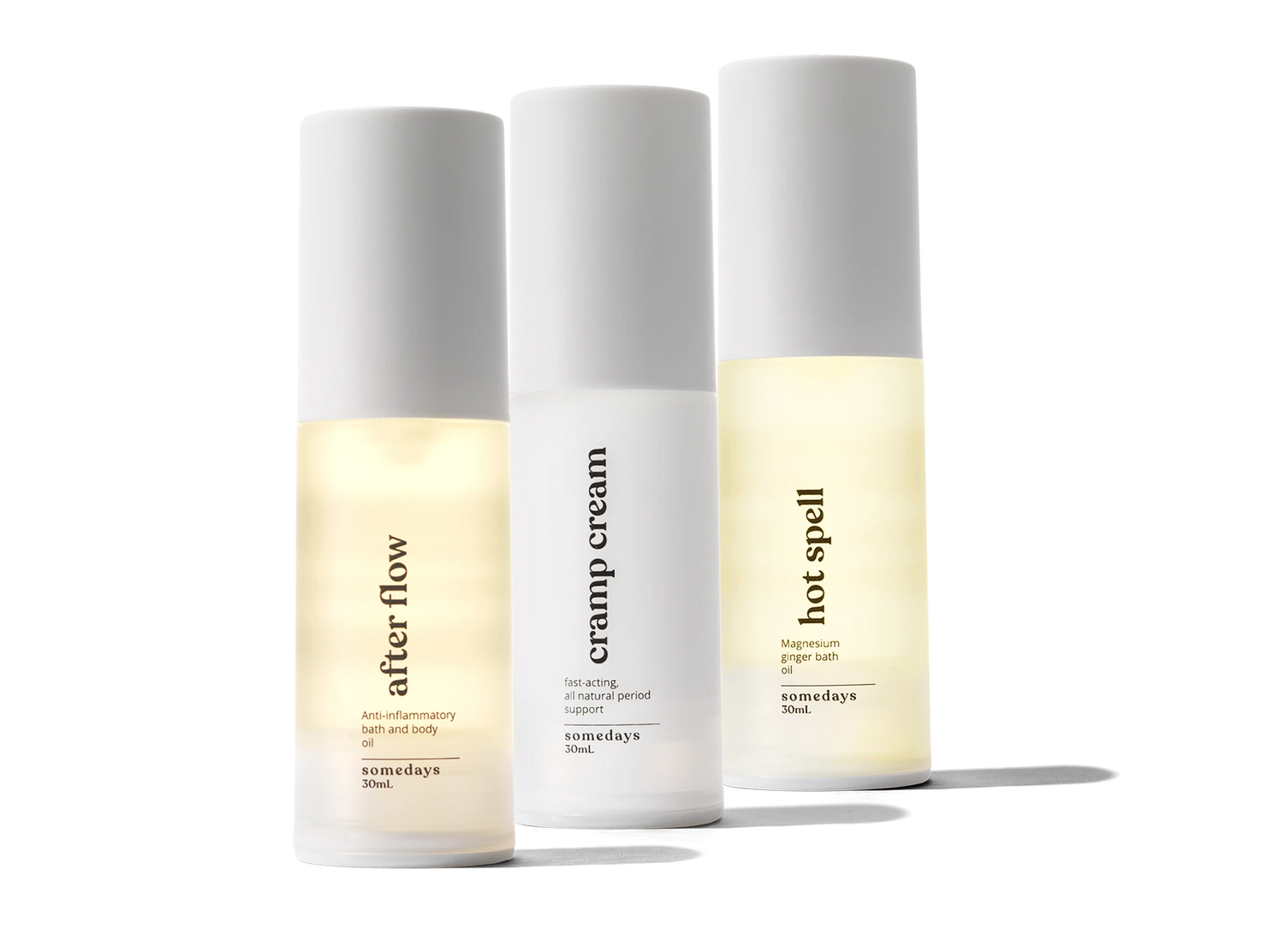How To Grocery Shop In Sync With Your Menstrual Cycle

If you’ve researched what to eat to have a happier, more pain free menstrual cycle, you may have come across a few different grocery lists of what you should buy for the different phases of your cycle. An intentional and personalized diet may help you better work in harmony with your hormones as they fluctuate.
It's important to keep in mind that your body is always communicating with you, and as you develop your intuition and begin to recognize patterns, it will tell you what it needs more of and what it can do without. As you continue to eat in sync with your cycle, you will eventually get to a point where you start to understand your body in depth, so you know how to best care for it.
It's important to consume different foods at different times to balance and optimize your hormones throughout the 4 phases of the menstrual cycle. The common understanding is that these phases cycle through every 28 days, but they can actually range anywhere from 21-35 days long.
A Brief Overview of The Phases
1. Menstrual Phase
The menstrual phase begins the very first day of your period. This phase is when you bleed, shedding the lining of the uterus. This happens when an egg was not fertilized, and the body received the go ahead to shed via a drop in the hormones estrogen and progesterone. A substance called prostaglandins causes the uterus to contract, which is how the bleeding begins.
2. Follicular phase
After you bleed for 3 to 7 days, whatever your norm is, there is a small gland in your brain called the pituitary gland which starts producing a hormone called the follicle stimulating hormone, or FSH. FSH communicates to your ovaries to start maturing eggs, anywhere from 5 to 20 in number, within their follicles. When those eggs begin to accumulate, they cause the hormones estrogen and testosterone to be produced, which helps build up the lining of your uterus.
3. Ovulatory Phase
During your ovulatory phase, estrogen reaches its peak and causes the surge of a hormone called the luteinizing hormone (LH). LH tells your ovaries to pick the healthiest egg to make its way into the fallopian tube. That egg will burst out and sit in the fallopian tube anywhere from 12 to 24 hours. This is when the body is the most fertile.
4. Luteal Phase
After that chosen egg bursts out of its follicle, the follicle basically collapses in on itself like a black hole and creates something called the corpus luteum. The corpus luteum starts producing the hormone progesterone, otherwise known as the ‘calming hormone’. Its primary responsibility is to maintain the uterine lining right up until our menstrual cycle starts, and the entire process begins again.
Now that we have a basic understanding of the different hormones that are at play and their contributing roles throughout the menstrual cycle, let’s talk about what kind of foods we can eat to support the process. The biggest thing to remember with this food list is that ideally, you should eat a variety of these foods at each point of your cycle. As everything on this list is beneficial to the entire body, it should be a good jumping off point to guide you towards a variety of foods that support the body as it cycles through each phase.
Follicular Phase
During the follicular phase, I love recommending people to start increasing vegetable and fruit intake, specifically in terms of colour variety. This means eating the entire rainbow, in addition to eating more high quality protein. Protein helps support egg development which is so important during this time. Also, strive to incorporate a range of fats like hemp seeds or chia seeds, which are great for supporting your cervix as it begins to prepare for ovulation in the next phase. Also be sure to drink more water to continue to hydrate the cells in your body!
|
Follicular Phase Food Group |
Grocery List |
|
Protein |
Chicken, turkey, duck, lamb, protein powder, & soy beans |
|
Fats |
Hemp seeds, chia seeds, sunflower seeds, pumpkin seeds, macadamias nuts, almonds, walnuts, and pistachios |
|
Purple Fruits & Vegetables |
Blueberries, blackberries, eggplant, prunes, fig, passionfruit, black olives, black rice, prunes |
|
Green Fruits & Vegetables |
Kale, asparagus, green apples, avocado, zucchini, lime, sugar snap peas, cabbage |
|
Red Fruits & Vegetables |
Red apples, cherries, tomatoes, radish, raspberries, cranberries, watermelon |
|
Orange Fruits & Vegetables |
Orange, apricot, peaches, tangerines, carrots, mangoes, papaya |
|
White Fruits & Vegetables |
Cauliflower, banana, garlic, fennel, leeks, onions, peaches, ginger, shallots |
|
Grains |
Quinoa, brown rice, GF bread, wholewheat bread, oats, whole buckwheat |
Ovulation Phase
During ovulation, focus on making sure you continue to eat quality protein and eat the rainbow in terms of fruits & vegetables. Also start increasing your fats during this time, especially if you notice that you have trouble getting good quality cervical fluid as you get closer to ovulation.
|
Ovulatory Phase Food Group |
Grocery List |
|
Protein |
Bison, quail, venison, protein powder, & soy beans |
|
Fats |
Salmon, white bait, sardines, coconut yogurt, cashews, brazil nuts, peanuts |
|
Water |
2 to 3 litres per day |
|
Purple Fruits & Vegetables |
Sapphire potatoes, plums, purple carrots, elderberry, purple cauliflower |
|
Green Fruits & Vegetables |
Kiwi, celery, green apples, romaine lettuce, cos lettuce, avocado |
|
Red Fruits & Vegetables |
Blood oranges, red bell peppers, strawberries, watermelon |
|
Orange Fruits & Vegetables |
Cantaloupe, orange bell peppers, sweet potatoes, butternut squash |
|
White Fruits & Vegetables |
Turnips, mushroom, horseradish, pear, lychee |
|
Grains |
Quinoa, brown rice, GF bread, wholewheat bread, oats, whole buckwheat |
Luteal Phase
The luteal phase is where most people notice various menstrual related issues arise, such as endometriosis pain, breast tenderness, acne, bloating, constipation, mood swings, night sweats, headaches, or migraines. You may also notice that you start spotting, which is a sign of low progesterone and high estrogen. The key to supporting progesterone levels is to support your liver. You will want to focus on quality fats and eat lots of dark greens. Be sure to continue increasing your protein and fats.
|
Luteal Phase Food Group |
Grocery List |
|
Protein |
Buffalo, kangaroo, goat, mutton, protein powder & soy beans |
|
Fats |
Tilapia, salmon, white bait, sardines, poppy seeds, mustard seeds, linseed (flaxseeds) |
|
Water |
2 to 3 litres per day |
|
Purple Fruits & Vegetables |
Beetroot, purple grapes, purple sweet potatoes, black olives, purple cauliflower |
|
Green Fruits & Vegetables |
Brussel sprouts, broccoli, kale, spinach, bok choy, green bell peppers |
|
Red Fruits & Vegetables |
Red beets, cherries, strawberries, radish, cabbage |
|
Orange Fruits & Vegetables |
Orange bell peppers, carrots, butternut squash, pumpkin |
|
White Fruits & Vegetables |
Cauliflower, ginger, potato, onions |
|
Grains |
Quinoa, brown rice, GF bread, wholewheat bread, oats, whole buckwheat |
Menstrual Phase
During your period you may be feeling more tired, fatigued, and wanting to rest more. This means you may not want to put too much effort into making big meals, which makes sense! However, we want to work on bringing nutrients back into our body that we lose due to our bleed.
|
Menstrual Phase Food Group |
Grocery List |
|
Bone Broth |
Any type of animal bones & scrap vegetables Can also buy premade in your local health food store! |
|
Protein |
Liver pate, buffalo, chicken, turkey, kangaroo, goat, mutton, protein powder & soy beans |
|
Fats |
Tilapia, salmon, white bait, sardines, poppy seeds, mustard seeds, linseed (flaxseeds), peanuts, |
|
Water |
2 to 3 litres per day |
|
Purple Fruits & Vegetables |
Beetroot, purple grapes, purple sweet potatoes, black olives, purple cauliflower |
|
Green Fruits & Vegetables |
Brussel sprouts, broccoli, kale, spinach, bok choy, green bell peppers |
|
Red Fruits & Vegetables |
Red beets, cherries, strawberries, radish, cabbage |
|
Orange Fruits & Vegetables |
Orange bell peppers, carrots, butternut squash, pumpkin |
|
White Fruits & Vegetables |
Cauliflower, ginger, potato, onions |
|
Grains |
Quinoa, brown rice, GF bread, wholewheat bread, oats, whole buckwheat |
It is worth noting that due to budgetary constraints and the availability of produce in your area, aiming for the “ideal” diet can sometimes be a lofty goal. The goal here isn’t to tell you exactly what to eat every day, but to provide a framework to guide your grocery shopping trip. Trying your best to eat sustainably is always admirable!
In sum, a balanced and optimal diet requires a deeper understanding of the different phases of the cycle and the hormones involved. By paying close attention to the signs your body is telling you, and keeping a good balance of proteins, fats, and a wide variety of vegetables in your diet, you can use food as fuel to help support hormone health and menstrual wellness.
Previous Article All Articles Next Article
All ArticlesBetter Cycle Kit
A traditional castor pack with a modern twist to support hormone health and reduce period pain. This science-backed treatment is a game-changer for painful cycles and mood swings.
- Relieve chronic period pain
- Enhance circulation and lymphatic drainage
- Decongest the uterus, ovaries, and fallopian tubes
- Support fertility, fibroids, ovarian cysts and endometriosis scars/adhesions
- Safely combine with TTC fertility programs and hormone replacement therapies
Includes: Belly Jelly Castor Stick 25g, Bamboo Belly Band, Zip Pouch, Flaxseed Heatpad, Custom Embroidered Cover, Heatpad Carrying case
$117.00
ADD TO CART



